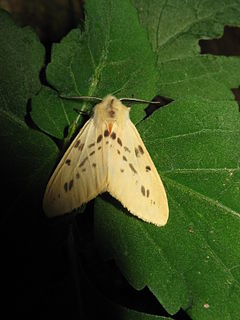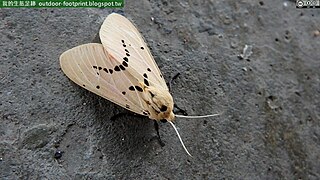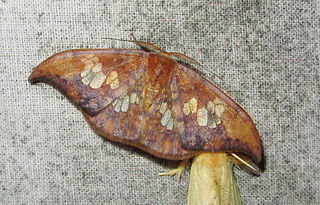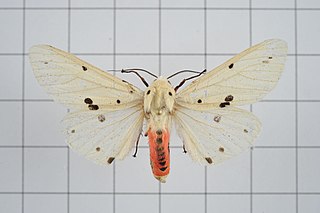
The buff ermine is a moth of the family Erebidae. It is sometimes placed in the genus Spilosoma. The species was first described by Johann Siegfried Hufnagel in 1766. It is found throughout the temperate belt of the Palearctic region south to northern Turkey, Georgia, Kazakhstan, southern Siberia, eastern Mongolia, Amur Region, China, Korea and Japan.

The Spilosomina are a subtribe of tiger moths in the tribe Arctiini, which is part of the family Erebidae.

Lemyra is a genus of tiger moths in the family Erebidae. The genus contains many species from East and South Asia, Sundaland and Australia. It was described by Francis Walker in 1856.

Spilarctia is a genus of moths in the family Erebidae. The genus was erected by Arthur Gardiner Butler in 1875.

Asota is a genus of moths in the family Erebidae first described by Jacob Hübner in 1819. Species are widely distributed throughout Africa, India, Sri Lanka, Myanmar, the Malayan region and tropical parts of the Australian region.

Marumba is a genus of moths in the family Sphingidae first described by Frederic Moore in 1882.

Agnidra is a genus of moths belonging to the subfamily Drepaninae.
Spilarctia todara is a moth of the family Erebidae. It was described by Frederic Moore in 1872. It is found in eastern India.
Spilarctia rubilinea is a moth in the family Erebidae. It was described by Moore in 1866. It is found in Nepal, India, Bhutan, Myanmar, Vietnam and China.
Spilarctia moorei is a moth in the family Erebidae. It was described by Snellen in 1879. It is found on Sulawesi.
Spilarctia leopardina is a moth in the family Erebidae. It was described by Vincenz Kollar in 1844. It is found in Tibet, Nepal, the north-western Himalayas and Kashmir.
Spilarctia seriatopunctata is a moth in the family Erebidae. It was described by Motschulsky in 1861. It is found in Russia, China, Korea and Japan.
Spilarctia nydia is a moth in the family Erebidae. It was described by Arthur Gardiner Butler in 1875. It is found in Nepal, China, Taiwan and northern Vietnam.
Spilarctia gopara is a moth in the family Erebidae. It was described by Moore in 1860. It is found in the Indian states of Sikkim and Assam and in Nepal.
Spilarctia punctata is a moth in the family Erebidae. It was described by Frederic Moore in 1859. It is found in India in Myanmar and on Java and possibly Borneo.

Spilarctia alba is a moth in the family Erebidae. It was described by Otto Vasilievich Bremer and William Grey in 1853. It is found in China, Taiwan and Korea.
Spilarctia bipunctata is a moth in the family Erebidae. It was described by Franz Daniel in 1943. It is found in Yunnan and Sichuan in China.
Spilarctia mona is a moth in the family Erebidae. It was described by Charles Swinhoe in 1885. It is found in southern India.
Spilarctia cervina is a moth in the family Erebidae. It was described by Hans Daniel Johan Wallengren in 1860. It is found on Sumatra and the Mentawai Islands of Indonesia.







